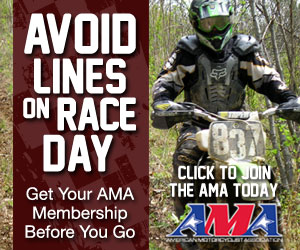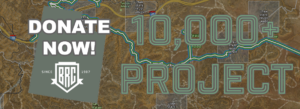Originally Appeared in May 1998 Issue
For Beginners…
Everyone has great advice for beginners. Of course, not everyone agrees. Well, we at All-OffRoad are no exception. We all have different riding abilities and preferences. If you read most of our articles, you’ll begin to learn what they are. With this in mind, for our For Beginners column, we are going to try to present a cross section of ideas and opinions and let you decide what’ll work for you.
This month we all basically agree, but each one of us has our own twist on things. So, let’s begin…
What type of dirt bike would you recommend for a beginner?
Ev’mon:
It depends greatly on the size and age of the rider and what type of riding he or she is interested in. Generally speaking, I recommend a small dual-sport style bike to beginners (this includes enduro bikes converted to street-legal). I think four-strokes are great to learn on because, generally, while they are a bit heavy, they are easy to ride. However, I’m sure some of my companions will argue this fact. One advantage of this type of bike is that they can be ridden on the street (assuming the rider is old enough) which could give the rider more seat time. In my opinion, four-strokes, generally, are lower maintenance and are easier to maintain.
They are also much more reliable than two-strokes. I will add the disclaimer that if the intention were to race motocross, a two-stroke would be a better choice. For many people the transition from four-stroke to two-stroke is tough.
I recommend that beginners buy an older used bike. I do this for several reasons. Beginners will usually crash. Doing this on an older bike is much less traumatic mentally. Usually, older bikes require more maintenance and are slightly less reliable the newer bikes. This gives the rider the added benefit of becoming much more familiar with their hardware (a good thing for all dirt bikers). I realize this contradicts my argument against two-strokes, but I think it’s a much different scale in comparison.
Also, unfortunately, several people invest tons of money in new hardware only to decide later that dirt biking isn’t really their idea of a good time. While this is fortunate for those of us that love to get those killer deals on a never-ridden used bike, it’s unfortunate for the poor sap that dished out all of those bucks.
Conehead:
Get the heaviest, largest, most powerful dual-purpose bike you can afford and then tough it out. You may crash a lot, but the experience you will gain will be well worth it.
Seriously, get a bike that fits you that you can afford. A beginner’s bike should be light and small. It may not be good form to sit on the seat and paddle your way with both feet over obstacles, but it is much more fulfilling to make it through some gnarly terrain by paddling than it is to show good style and then crash your brains out. Take it from the expert. Make sure you can reach the ground flat footed while astride any bike you are considering.
The best affordable dirt bike is one that someone else buys for you. Start whining now to your dad (or spouse) that you really need a new bike and that you will pick up your room and do all your chores for the next year. (If it’s your spouse, you may have to promise them a new kid, like Ev’mon did, as well.) If you do have to pay for your own bike, I agree with Ev’mon, get a used bike. I also recommend buying a Japanese-brand bike. KTMs, Husabergs, and such may be cool, but parts are typically not as cheap and readily available. (Actually, Husabergs suck because their seat heights are up at my arm pit.)
The Rookie:
A used (yet in good shape), mid-size 2-stroke. I started (and am still on) an ’82 KDX-200, and I think it has been an ideal intro machine. I have since taken up riding an XR-500 as well, but I am glad I was able to learn on the KDX. A bike such as this is good for a variety of reasons. The first and foremost thing to expect when learning is that you WILL crash, and most likely crash often. You will be picking this bike up over and over and over, so you want it to be as light as possible. If your fondest memory of your virgin bike trip is that you did 10 reps of dead-lifting 500 pounds and then threw up, you may become disenchanted with the whole concept. Another weight advantage is that the bike will be more maneuverable. It will be easier to learn the fine art of finesse if the bike isn’t telling YOU where to go.
I also say a 2-stroke over a 4-stroke for simplicity’s sake. The 2-stroke offers a more basic design which makes repairs and adjustments that much easier. And on a used bike, you WILL become familiar with the parts in hurry. On my first outing, my clutch cable snapped. After repairing that, I discovered that some grit had entered my carb and was fouling things up. So, I then got to disassemble the carb. This was all before I even got to ride AT ALL…but I digress.
Something else to consider is what your friends (or instructor or whatever) will be riding. If they are riding 2-strokes, then they will have the experience to pass along to you. Also, you will most likely fit into their type of riding and hence have more opportunities to ride. If they are all on street-legal 4-strokes and are doing dual-purpose rides, then you will be left behind on many a trip. This may be the most important point to remember. Individuality is great, but as a beginner, you want to tap the resources available to you…and onto the next question…
Pinhead:
Dual sport vehicles offer the greatest potential for most riders interested in dirt and street yet with a limit on cost. I recommend the following:
Always begin riding predominantly in the dirt. Dirt offers a challenge that is unavailable without excessive speed on the street. Dirt also offers a second chance when mistakes happen, and they do. Often street riding does not.
When buying a dual sport, watch out for lame designs so common of factory “dual sport” bikes. The last thing a beginner needs is a 350 lb vehicle that is slung on tooth-pick forks. It took the entire 1980’s to convince most manufacturers that dual sport bikes weren’t going to be used the way most pansy’s use SUVs. When buying a dual sport focus on the suspension and frame design. Rigid forks (large diameter) forks and a real suspension (cartridge designs really help) will help you feel whether the front end is in the air or on the ground during hill climbs and will help you survive the hard landings while maintaining control.
Ignore Conehead’s advice entirely. The average American has no desire to take the abuse I’ve personally witnessed that man take time and time again. It has permanently disfigured his body in multiple places. Ultimately, we all must eventually admit that we are warm, soft, and squishy on the inside. It’s really just a matter of how much abuse it takes for one to arrive at such a conclusion. Few of us have the impact strength and moldability of a sliver of bailing wire (see any picture of Conehead.) Successive poundings have reshaped it, yet it still manages to remain in one semi-functioning piece. So, take it from the old guy, just don’t forget to invert the polarity when required.
What other resources should they take advantage of when deciding on a bike?
Ev’mon:
Talk to friends or locate a local club and ask questions. Once a model is targeted find out as much as possible about it. Don’t pay too much attention to magazine reviews. It seems that most of the reviewers are hard-core maniacs and can’t be happy with anything unless they spend an additional $10,000 to make it better, or it comes from an advertiser – Sorry, just being a little snide. On a more serious note, one issue will claim it the “Bike of the Year” and two months later the same people say that the bike is junk and isn’t worth looking at.
Conehead:
I think you SHOULD check out mag reviews because they often show important statistics on a prospective bike. Make sure to check out the dry and wet weights. Anything above 260 pounds dry is too heavy for a beginner. A heavy bike will tire you quickly. Take reviewers’ opinions with a grain of salt, though.
The Rookie:
Friends who ride are your best bet for info. I’ve never been able to keep one mag review straight from another. I can ALWAYS count on my friends to have an opinion. Plus, a friend may have a spare old bike he’d let go cheap just for the chance to see you try and learn to ride it.
Pinhead:
One’s that appear to work and be accurate. Magazines sometimes give sensible advice but then contradict themselves within the same year. Be discriminating and selective. Evaluate the accuracy of information and survey better sources when it’s time for an important decision.
What are your recommendations for riding gear for beginners?
Ev’mon:
I always recommend full protection. I don’t have any particular brand that I would push. I will say, don’t spend tons of money. I know of people that wear gloves from the hardware store and hockey kneepads and are perfectly happy.
Conehead:
Full protection is important. The most important, of course, is a good helmet and goggles. Get a white, Snell approved helmet. Solid white helmets are the best choice because they are cheaper than a helmet with graphics and white is the coolest for temperature. Bieffi helmets are the cheapest Snell helmets. They do not fit everyone’s head, though. Shoei helmets fit the best and have always been my favorite. (Some people say I have a fat head, though.) Buy Scott goggles, because practically everyone has replacement lenses for them. Gloves, boots, knee and elbow pads are also a must. Get all of these as cheap as you can.
The Rookie:
The more gear, the better. Remember, you WILL crash. Helmet, goggles, boots, gloves, knee and elbow pads are a MUST. They don’t have to be expensive, either. Cheap will work, it just may not be the best fit, have the best finish, or last as long. Get better at riding before you consider getting better gear. You may find you don’t have a taste for riding after a few trips, and you don’t want to be stuck with a bunch of slightly used high-end equipment. And if you do keep riding, your cheaper gear will enable you to keep riding while you shop for upgrades. Once you’ve ridden a bit, you will have a little more insight into what kind of gear YOU feel would be best, rather than what the mags and advertisers tell you is best.
Oh, I almost forgot. GET A KIDNEY BELT! You will find that there are some muscles in your lower back that you never knew you had. Your first trip of any distance will give these muscles a voice, and they will be screaming “GET A KIDNEY BELT!”
Pinhead:
Helmet and gloves are mandatory. Serious riding with beginners also requires fore-arm guards, boots, knee and shin guards, and the grass hopper shell in that order.
How about maintenance tips?
Ev’mon:
Buy the service manual and read it several times. If you don’t understand something, ask, don’t guess. Most importantly, don’t change your oil at midnight when you’re drunk (a story for another time).
Conehead:
Go ahead Ev’mon, tell the story…
Do purchase and read the service manual. Perform whatever maintenance it says. Just as important, maintain your body. Buy a camelback, fill it, and wear it whenever you ride. You can live for days without food. You can’t without water.
The Rookie:
Get a REAL manual. The one that came with my KDX-200 was about 5 pages long, including the index. And if you looked up something like “carb adjustments”, it referred you to a blurry black and white photo of a carb with the caption “here is the carb if you want to adjust it”. Get a manual that explains with words and photos how to do EVERYTHING to your bike, because if you ride long enough you will end up doing EVERYTHING to it, plus a little more. Unless you are very familiar with the seller (a good friend), assume a newly purchased used bike will require the minimum of a fluid change, a filter cleaning, and a new spark plug. In general, keep the fluids full, the filter clean, and a spare sparkplug handy and rock-n-roll.
Pinhead:
Again, choose your sources carefully. If you’re a lame mechanic, don’t try to make technical decisions without basis. Most of all, don’t forget the results you get from the different approaches you do try. Moto-mechanics just isn’t a one-paragraph course.
OK, so I have a bike and riding gear, what’s next?
Ev’mon:
Find some other riders and go riding! Ok, so maybe a class from MSF (Motorcycle Safety Foundation) or someplace similar would be in order first.
Conehead:
Set up your new/used bike so it fits you. You should be able to stand on the pegs, knees slightly bent, and comfortably drop your arms so your hands are on the controls. If it feels like a long reach down to the controls, the handle bars are too low. Rotate them forward a bit until they are comfortable. Rotate the brake and clutch perches so they are also in a comfortable position for you. Next, check that the rear brake pedal and shift levers can be operated while standing. Adjust them accordingly. Finally, set your shock and fork preload to get at least 100 mm of sag. Up to 150 mm does not hurt for a beginner (or an old twit like myself). You should not be jumping large obstacles as a beginner, so G-outs and bottoming (things they write about in the mags) are not a concern.
The Rookie:
Get hungry. Go riding as often as you can. Push yourself a little more each time. Watch and learn from your buddies and your own successes and failures. Perfect your style. Have fun.
Well, how should I find places to ride and people to ride with?
Ev’mon:
There are a lot of resources. There are a ton of Web sites with “Places to Ride” listings. Several motorcycle dealers have literature. You can check with the BLM and the USFS in you’re area. Many counties have county parks.
To find riding buddies, look for local clubs or checkout the rec.motorcycles.dirt USENET group.
Conehead:
Hopefully you know somebody who has a truck, van, or trailer who is willing to take you with them when they go riding. If not, check with local dealers to get hooked up with a local club. If you live in the South SF Bay Area, are female, cute, and single, send me an e-mail and we will take you along.
The Rookie:
Talk about your newfound love of riding. You may be surprised to find that someone in your office, your neighbor, even a friend you thought you knew is into riding as well. If YOU don’t bring it up, it may never come up. You may even convince someone to get into it with you. My only other thought is a self-serving plug…go to www.All-Offroad.com.
Do you have any last advice for new riders?
Ev’mon:
Have fun and keep checking All-OffRoad for more tips for beginners!
Conehead:
Do not ride with Pinhead. He laughs when you are in pain. Seriously, start out slow and try to find someone to ride with who has lots of patience. Most importantly, do not ride by yourself. If you must ride by yourself, make sure someone who cares knows exactly where you are going and when you plan to be back.
The Rookie:
Better safe than sorry. Push yourself to get better, but do it gradually. You won’t be the greatest overnight, or even over a weekend. What if you break your back on a black diamond trail that is completely out of your league and can never ride again? After some practice, maybe you COULD have ridden that black diamond successfully, but now you’ve blown it completely and will never know. Use your head, obey the laws of physics, and have fun.
Pinhead:
Ride on mother!





